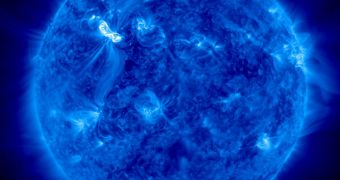Due to the massive solar flares that burst forth from within the Sun on Tuesday, March 6, our planet is currently (March 8) being bombarded by the largest charged particle cloud in the past five years. The event will most likely give rise to significant auroral displays at the poles.
The clash between the solar particles and Earth's magnetosphere is scheduled to last for at least a day, during which time we may experience a host of negative side-effects, such as for example broken power grids, damaged satellites, and impaired communications.
When solar particles impact our planet, they are immediately transmitted along the magnetic field lines above the poles. The bright and amazing auroras that develop in the high-latitude sky following a coronal mass ejection (CME) are the direct result of this phenomenon.
This is precisely what is happening now as well. Vast amounts of plasma and charged particles released by the Sun two days ago are now heading towards, and colliding with, Earth. Astronomers are a bit worried about the fate of spacecraft in orbit, including the International Space Station (ISS).
Solar physicists estimate that the shock wave the Sun produced traveled the astronomical unit (AU) separating the two bodies at a speed of 4 million miles (6.43 million kilometers) per hour
The geomagnetic storm is expected to have begun at 1:25 am EST (0625 GMT) this morning. The full force of the solar blast is expected to hit our planet at around 7 am EST (1200 GMT). Fortunately, the material released by the CME will only deliver a glancing blow to the planet, Space reports.
“There is the potential for induced currents in power grids. Power grid operators have all been alerted. It could start to cause some unwanted induced currents,” US National Oceanic and Atmospheric Administration (NOAA) weather scientist Joseph Kunches told the media yesterday.
A few commercial airliners have already been warned about the impending impact. There are currently many companies that prefer to conduct flights between North America and Asia or Europe, for example, above the North Pole. This particular area will be the most severely affected.
“Such a CME could result in a severe geomagnetic storm, causing aurora at low latitudes, with possible disruption to high frequency radio communication, global positioning systems (GPS), and power grids,” a statement from NASA adds.
On the bright side of things, the event is expected to produce bright and shiny auroras, which may be visible from lower-than-usual altitudes. Skywatchers should keep an eye out for these lights tonight.

 14 DAY TRIAL //
14 DAY TRIAL //